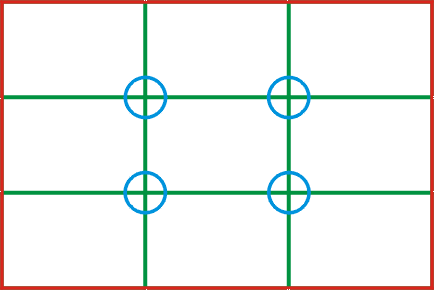
Photographic Composition Guidelines
by: Paul Illsley

Photographic Composition Guidelines
by: Paul Illsley
Pre-visualization:
Before you record an image, take a couple of seconds and look at the entire scene. Think of the “emotion” or “message” you wish to express in the image. This “emotion” will give you a clue to which guidelines you may wish to use. This pre-visualization process allows you the time to reflect on the creative process in order to record the image the way you wish. Each image you record should be deliberate and intentional. The more images you record in this manner, the more you will be able to express to others what you are experiencing at that moment. Over time this process will become second nature and will be the foundation for all of your great images.
Rule of Thirds:
This simple guideline has been used for centuries and is one of the most used composition techniques. Once you have been introduced to it you will be able to identify it’s use in many of the great paintings and images. The “Rule of Thirds” simply states that an image can be divided into three horizontal sections and three vertical sections and, that the four intersection points (shown in blue) formed by these transition lines (shown in green) are great areas to place important components of your image. One handy use of the rule of thirds is to place the horizon in an image near one of the two horizontal lines (you can also place vertical objects along the vertical lines). This helps to add a dynamic balance to your image.




Foreground, Middle and Background:
It is hard to recreate the illusion of depth in photographs. Because we see the original scene in 3D we have a sense of depth. In order to recreate the illusion of depth on a flat photograph (or computer screen) we must recreate the illusion of depth. This is done by making sure you include something in your image that represents the foreground, middle ground and something which indicated distant objects. This “layering” helps to create the illusion of depth. The horse image located at the top of this page is a good example of the use of foreground, middle and background layering.






Leading Lines:
Look for natural lines that will lead the viewer’s eyes to the subject of the image. Streams, fences, roads, trails, bridges (to name only a few) can all be used to direct the viewers attention to the subject of the image.



Pattern:
Keep an eye out for patterns in nature. Geometric or reoccurring patterns often make interesting images. Think about only recording a portion of the full pattern, this leads the viewer to think that the pattern continues well outside the image area.



Simplicity:
Think about simplifying your image so there aren't any items that will distract from the focus of the scene. Try to keep the background simple and uncluttered (this is very important). You may have to move your shooting position in order to accomplish this but it will help bring attention to the important focus of your image. Be careful not to have prominent lines (buildings, trees, poles) intersect the subject of your image. These intersecting lines (called mergers) will distract attention from your subject and can make for a confusing image.



Point of View:
Be prepared to change your position in order to record that interesting image. You may have to stand on a fence, lay on the ground, kneel behind a bush or climb a rock to get that unique angle. It is often best to get on the same level as your subject. If you are photographing mushrooms or insects you may have to lay on a foam pad or a blanket in order to get that interesting shot. Be creative and look for interesting vantage points. You may have to do some work to get the right angle but your efforts will pay off in the long run.



Tripod:
A tripod is not a necessity for good landscape or nature photography but it is a great tool if you are willing to use it. I use my tripod all the time and I don’t know what I would do without it. A tripod is useful for many reasons. It allows you to record images under low light conditions (or long time exposures such as images of flowing water which may require exposure times of one or more seconds in duration). It helps to steady the camera so you can get sharper images (lessens camera shake due to hand holding the camera in the cold or wind). It slows you down so you have time to think through each image before you record it. This extra time allows you to compose the image and it offers you the opportunity to look for better perspectives or compositions while still retaining the original composition.



Patience and Curiosity:
Be patient, not all of your images will become award winners but if you practice these simple guidelines you will find that more and more of your images will become works of art. Practice makes perfect. Pay attention to the things that work and those that don’t. Learn from your mistakes and successes. Play with your camera and explore the scene you are photographing. You may find yourself laying on your back photographing a flower from underneath, or you might find yourself standing on a rock in order to get that great shot. Before you record every image ask yourself “am I being creative” and “can I record this image another way”. Whatever you find yourself attempting, make sure you have fun.